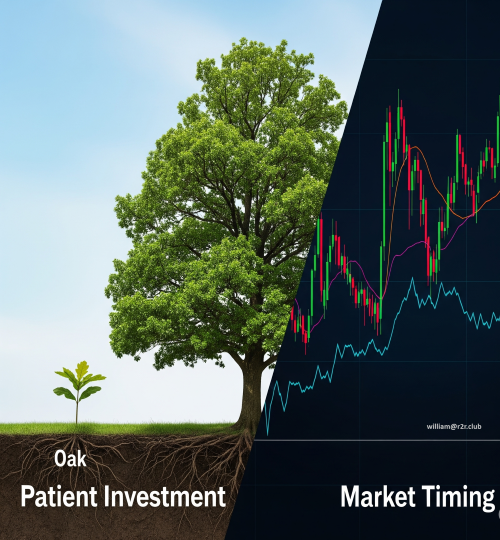The old adage holds true: for the average investor, building wealth is more like planting a tree than playing the lottery. It’s about “time in the market,” not “timing the market,” especially when you focus on buying real value.
What Is Timing the Market?
Trying to “time the market” is the stressful game of guessing the absolute best time to buy and sell stocks. It’s tempting to think you can jump in at the lowest point and cash out at the very peak. But the reality is, even the most seasoned professionals with all the data in the world struggle to do this consistently. It’s like trying to catch a falling knife – you’re more likely to get hurt than to grab it perfectly.
The Power of Time in the Market
This is where the wisdom of “time in the market” comes in, especially when combined with a “value investing” approach. Value investing is simply about buying good companies at a fair price. Think of it as buying a solid, well-built house in a good neighborhood for what it’s actually worth, not for an inflated price during a housing boom. You’re confident in its long-term value, regardless of short-term market fluctuations.
Real-World Lessons in Patience and Peril
The Power of Patience: Warren Buffett and Apple
A perfect modern example of successful value investing is Warren Buffett’s investment in Apple. For years, Buffett famously avoided tech stocks. But starting in 2016, his firm, Berkshire Hathaway, began buying Apple shares. He wasn’t trying to time the bottom of a stock dip or predict the next iPhone launch. Instead, he saw Apple for what it had become: a consumer products company with an incredibly powerful and loyal ecosystem.
Buffett understood the immense value of the iPhone and how it locks customers into Apple’s world of services and other products. He saw a company with:
- A powerful brand
- Tremendous earnings
- A loyal customer base
In other words, a quality business selling at what he considered a reasonable price.
He bought and held, even as critics questioned the move. By staying invested, Berkshire Hathaway has seen its Apple position grow to become its single largest stock holding, generating tens of billions of dollars in gains. Buffett’s success wasn’t from a lucky guess; it was from identifying the true, long-term value of the business and having the patience to let his investment flourish.
The Pitfall of Timing: A Wall Street Legend’s Mistake
Now, consider the cautionary tale of Stanley Druckenmiller, a legendary investor. During the dot-com bubble of the late 1990s, he initially shorted tech stocks (betting their prices would fall). However, as the bubble continued to inflate and he saw others making quick money, he abandoned his initial well-reasoned strategy. In his own words, he “couldn’t help” himself and jumped back into the tech frenzy at the very peak. The result? A staggering $3 billion loss in a matter of weeks when the bubble burst. If one of the greats can get it so wrong, what does that mean for the average investor?
The Investor vs. The Investment: The Magellan Fund Paradox
The story of the Fidelity Magellan Fund, managed by the legendary Peter Lynch, offers another powerful lesson. From 1977 to 1990, the fund achieved a phenomenal average annual return of 29%. You would think that every investor in the fund became incredibly wealthy. However, studies showed that the average investor in that very fund lost money. How is this possible?
Investors, driven by emotion, tended to:
- Pour money into the fund after it had a period of strong performance (buying high)
- Pull their money out in a panic when the market dipped (selling low)
Their attempts to time the market caused them to miss out on the incredible long-term gains of the fund.
The Takeaway for You, the Retail Investor
The lesson from these examples is clear:
- Stop trying to predict the unpredictable. The daily and monthly zigs and zags of the market are noise.
- Focus on what you can control: identifying good businesses. Look for companies with strong fundamentals, a history of profitability, and a product or service you understand.
- Think like an owner, not a gambler. When you buy a stock, you’re buying a piece of a business. Be prepared to hold it for the long term and let the value of that business grow.
By focusing on buying value and giving your investments the time they need to mature, you can build sustainable wealth without the stress and likely failure of trying to perfectly time the market.


interesting points